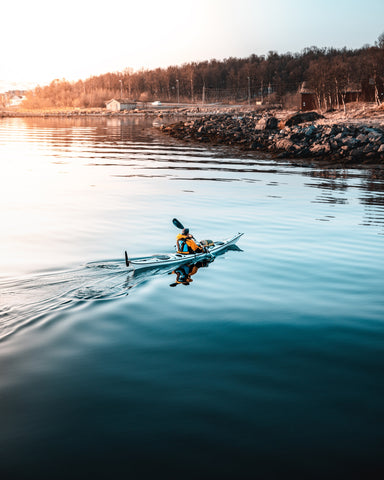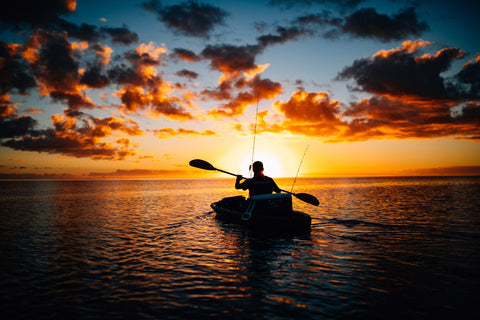How to Install a Kayak Seat
May 30, 2020
Kayaking is all about convenience and comfort. Kayak seats make your paddling experience that much more enjoyable as they provide you with much-needed back support and additional comfort.
Investing in the right kayak seat means that you can enjoy more time out on the water
Investing in the right kayak seat means that you can enjoy more time out on the water. So, how do you install your seat, and ensure that it is providing maximum comfort for your paddling adventures?
Installing your seat
Depending on your kayak seat, there will be some specific considerations which will be explained in the manual. However, here are our top tips for successfully installing your kayak seat, no matter the model:
- First, locate where you want to place your seat and the straps. Do you have a preferred location? This will depend on a number of factors including the size and shape of your kayak.
The seat position will largely depend on the size and shape of your kayak
- Next, place the seat into the kayak so that the fold of the seat rests snugly against the back of the seat area.
- Then, attach the clips to the fixings in your kayak.
Attach the clips to the fixings on your kayak
- Once the seat is attached, tighten the straps gradually until you are happy with the seat position. Ensure that you have taught straps – this means that the seat won’t move while you are paddling.
Top tip: if correctly installed, the backrest should end up slightly curved.
If correctly installed, the backrest should end up slightly curved. The backrest should be as close to vertical as possible to enable you to get the most power from your paddling.

The backrest should end up slightly curved when properly installed
Removing the seat
It’s easiest to slightly loosen one of the straps when you remove the seat – this provides enough ‘give’ to remove the seat. It also means that you only need to adjust one strap when you reattach the seat.
Maximise your comfort
The basics of attaching your kayak seat are relatively simple, but what about all the factors that will affect your comfort when out on the water? There are a number of adjustments you can make to best suit you. We’ll take you through some of those key considerations.
1. The back tilt – mix it up
Some paddlers prefer a lot of support high up, others want very little support. When using a seat with a back, remember that you can adjust it if you’re out on the water for a long time – from leaning back to stretch out, or close to vertical like the optimum paddling position noted above, variety can help you fight fatigue.
2. The hip tilt
No, we’re not talking about a dance move. Just like the back tilt, adjusting the tilt of your hips can make a big difference to your long-term comfort.
Tilting the seat at the front can be painful for paddlers with lower back issues, as it extends the lower back.
Play around with your hip position and find the right tilt for you.
But it’s down to personal preference as to whether the paddler wants their hips to be positioned flat, or tilted back or forward. Play around with your hip position and find the right tilt for you.
If your seat isn’t adjustable at the hips, other options include adding foam pads or an inflatable pad to change your position.
3. Change the height
The general rule is that the higher you sit, the more comfortable you will be. But the flipside is that you will also be less stable.
Find what works best for you in terms of balancing stability, comfort and power.
Higher seating improves the movement of paddling, but doesn’t provide enough stability in waves. Find what works best for you in terms of balancing stability, comfort and power.
For example, our Stadium Seat allows you to sit in a raised position for the ultimate back comfort.

Seats like the Stadium Seat allow you to sit in a raised position for ultimate comfort
4. Add thigh support
Many kayak seat areas aren’t long enough and don’t provide thigh support. Inflatable thigh supports are light and easily adjustable. However, you can also make your own with foam.
Just remember to fix the support, so that it doesn’t move while paddling.
5. Adjust the foot positionPlaying around with the position of your feet is another way to improve your comfort.
This is very dependent on personal preference, and the type of kayaking you do.
- Whitewater: those paddling in whitewater need to be fixed into the boat more firmly and often take a frog leg position. While it does reduce your rotation, it keeps the body well-connected to the boat for stability.
- Sea kayakers: those paddling in the sea often take out their foot pegs and pad the front of the boat to meet their feet. This allows flexibility for the feet to move depending on the conditions.
- Flat water: flat water kayakers have a similar feet position to sea kayakers, but they sometimes use foot straps to assist them with the push and pull of their legs. They have the lowest boat to body connection of all kayakers.

Flat water kayakers have the lowest body to boat connection
6. Knee positionThere are two primary knee positions available to you – high and outside, or low and in the centre of the boat.
In general, for normal cruising the knees are moving up and out on one side, and down toward the middle on the other.
For rough water, some paddlers have both legs up, in thigh supports or straps, to provide a better connection for bracing.
7. Back supportFinally, consider your back or lumbar support.
This support has numerous advantages, from keeping you in your boat in big waves, to providing back support when out fishing.
See our range of kayak fishing accessories.

Back supports have numerous advantages, including when out fishing
For beginners, lower backrests are generally better. You can also tilt the backrest back so that it doesn’t touch you when you’re paddling, but provides support when resting.
FIND OUT MORE:
- Don't forget the little ones! Meet the kids’ kayak backrest
- Ready to up your comfort levels? Explore Bay Sports kayak seats
- Looking for more kayaking info? Check out more Kayak Posts



